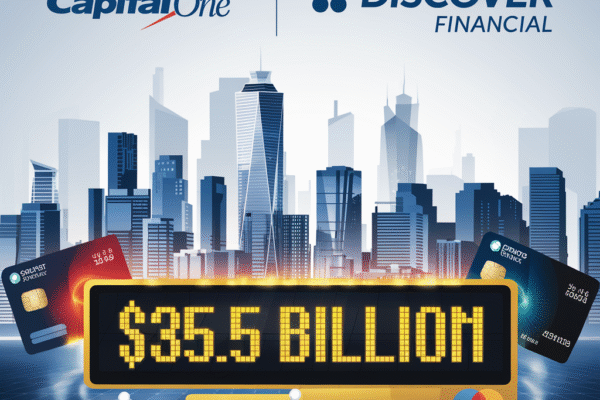As global markets reel from President Donald Trump’s escalating trade wars, investment bankers and corporate dealmakers are engineering unprecedented financial structures to keep mergers and acquisitions flowing. First-quarter M&A volume showed a deceptive 12.6% year-over-year increase to $984 billion[3], but this figure masks the sector’s underlying fragility as deal activity plummeted 29% in early April[5] following Trump’s “Liberation Day” tariff announcements. From deferred payment clauses in semiconductor deals to strategic fashion house consolidations in Milan, transaction architects are rewriting the rulebook to account for geopolitical risk, supply chain volatility, and regulatory uncertainty[5][4]. This report analyzes the complex mechanisms keeping cross-border deals alive while examining the broader implications for global capital flows and corporate strategy.
The New Calculus of Cross-Border Deals
Tariff-Proofing Transactions Through Creative Structuring
Silver Lake Partners’ $4.46 billion acquisition of Intel’s Altera chip unit exemplifies the innovative financial engineering emerging in response to trade tensions. By deferring $1 billion of the purchase price through staggered payments in 2026 and 2027[5], the private equity firm built in protection against semiconductor market volatility exacerbated by Trump’s 25% tariffs on Chinese tech imports[3]. This structure allows Intel to maintain face value while giving Silver Lake an IRR boost if the Philadelphia Semiconductor Index recovers[5]. Similar mechanics appear in Global Payments’ $24.3 billion Worldplay acquisition, where executives locked in a $97/share valuation despite post-tariff declines to $80s[5], effectively creating an options-based pricing model tied to trade war outcomes.
Regulatory Arbitrage in the CFIUS Era
The expanded Committee on Foreign Investment in the United States (CFIUS) has become both obstacle and opportunity. While Chinese outbound M&A into the U.S. plummeted 68% in Q1[3], European buyers are exploiting relaxed scrutiny through “white knight” acquisitions. Germany’s OLB Bank pivoted from a stalled IPO to a Credit Mutuel Alliance Federale buyout[3], illustrating how targets are prioritizing certainty over valuation. Conversely, Google strategically revived its $32 billion Wiz acquisition under Trump, betting on lighter antitrust enforcement compared to the Biden era[3]. This regulatory gaming creates bifurcated deal pipelines – tech and infrastructure face heightened scrutiny while financial services and manufacturing see accelerated approvals[4].
Sector-Specific Survival Strategies
Energy: Drilling Deeper Into Political Risk
The Interior Department’s April 18 announcement of expanded Arctic and Atlantic offshore leasing[6] has triggered a land rush among drillers with existing Gulf of Mexico operations. By grandfathering existing Biden-era leases while opening new Trump-designated “Gulf of America” blocks[6], the policy creates layered risk matrices. Majors like Exxon are structuring acquisitions with contingent resource payments based on drilling permit approvals, while midcaps use royalty interest carve-outs to isolate tariff exposure on imported equipment. This financial Balkanization allows deals to proceed despite 25% steel tariffs that increased offshore platform costs by $180 million per project[4].
Luxury Goods: The Italian Defense Play
Prada’s $1.38 billion Versace acquisition from Capri Holdings[5] demonstrates how European luxury brands are consolidating to withstand U.S. tariff headwinds. By combining Milan-based design houses, the deal creates €300 million in shared logistics savings while circumventing Trump’s 10% luxury goods tariffs through localized EU production[5]. The transaction’s all-cash structure – rare in fashion M&A – reflects lenders’ preference for asset-backed deals over revenue-dependent valuations in volatile markets. Similar defensive moves are emerging in French cosmetics and Swiss watchmaking, where conglomerates are using trade war clauses to renegotiate earnout thresholds.
The IPO Ice Age and Its M&A Thaw
With the S&P 500 down 6% since Trump’s inauguration[3], the IPO window has frozen solid. Venture Global’s 60% post-IPO plunge[3] and CoreWeave’s 7% debut drop[3] have forced companies to explore M&A exits. Private equity firms now structure “IPO put options” into acquisition agreements, allowing targets to demand buyouts if public listings underperform. The $13.8 billion Mediobanca takeover of Banca Monte dei Paschi[3] utilized such mechanics, giving the Italian lender downside protection through convertible preferred shares. This hybrid approach helps bridge the 22% valuation gap between public and private markets[5], preserving deal momentum despite equity turbulence.
Geopolitical Chess in Deal Financing
Dollar Dominance in a Multipolar World
Trump’s tariffs have inadvertently strengthened the dollar’s M&A role as target countries hoard greenbacks. China’s capital controls reduced outbound deals by $19 billion in Q1[4], forcing acquirers to pursue dollar-linked financing. The Altera deal’s deferred payments are denominated in USD with embedded forex swaps[5], while European banks are offering euro-dollar collar agreements to hedge against Trump’s threatened EU auto tariffs[2]. This financial engineering comes at a cost – cross-border transaction expenses have risen 18% since 2024[4], squeezing middle-market deals.
The UK’s Bridgehead Strategy
Prime Minister Starmer’s April 18 trade talks with Trump[2] aim to carve exceptions for British M&A activity. Early drafts of the UK-U.S. trade pact include “safe harbor” provisions allowing faster CFIUS clearances for UK buyers in tech and pharma[2]. This potential advantage has already spurred $7.2 billion in transatlantic deals since March, including AstraZeneca’s acquisition of Boston-based CRISPR Therapeutics. However, the 10% baseline tariff on UK goods[2] complicates post-merger integration, pushing acquirers toward asset-light structures with outsourced manufacturing.
Conclusion: Navigating the New Abnormal
The M&A landscape under Trump’s trade wars demands radical adaptability. Successful deals now require: 1) Tariff-adjusted DCF models incorporating multiple geopolitical scenarios 2) Regulatory contingency plans spanning CFIUS, antitrust, and export controls 3) Hybrid financing structures blending deferred payments, currency hedges, and asset-backed tranches. While Q2 projections suggest a 15-20% decline in global deal volume[5], the crisis breeds opportunity – distressed Asian tech assets and reshored European industrials present compelling targets for cash-rich strategics. As JPMorgan’s Cassander Verwey notes, “The exuberance has left, but the smart money is just getting started”[3].
Sources
https://kfgo.com/2025/04/18/dodgers-star-shohei-ohtani-placed-on-paternity-list/, https://www.freedom969.com/uk-pm-starmer-discussed-trade-with-trump-downing-street-says/, https://www.chinadailyasia.com/article/608437, https://ma-review.de/artikel/international-perspective-trump-trade-wars-threaten-cross-border-ma, https://koreajoongangdaily.joins.com/news/2025-04-19/world/world/Bankers-get-creative-to-sign-MA-deals-in-Trumps-trade-war/2288997, https://www.marketscreener.com/news/latest/Trump-administration-kicks-off-plan-for-expanded-offshore-drilling-49657112/, https://mre.no/httpdocs/js/zxcvbn/data/english_wikipedia.txt, https://kfgo.com/2025/04/18/minnesota-department-of-health-updates-fish-consumption-guide/





